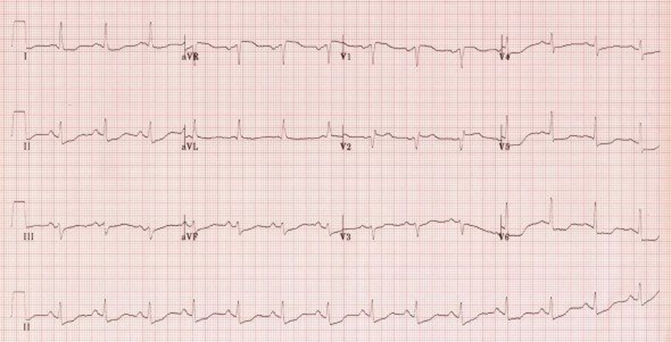Pharmacology Flashcard 3
Rationale
B. Rationale: Epinephrine and vasopressin are part of the asystole algorithm. Vasopressors are given as soon as IV/IO access is available. Epinephrine may be given every 3–5 minutes. Vasopressin may replace the first or second dose of epinephrine. Antiarrhythmics are not part of the asystole algorithm as there is an absence of rhythm. Atropine was removed from the asystole algorithm because it was determined unlikely to have any therapeutic benefit.
Question
Which of the following drugs are part of the asystole algorithm?
A. Epinephrine; atropine
B. Epinephrine; vasopressin
C. Epinephrine; vasopressin; amiodarone
D. Epinephrine; vasopressin; atropine
Answer
B. Epinephrine; vasopressin
Rationale
B. Rationale: Adding steroids, such as methylprednisolone, with epinephrine when treating patients with in-hospital cardiac arrest has shown improved survival rates in studies. It is thought that there is widespread systemic inflammation after cardiac arrest, and adding steroids can help patients when they have achieved a return of spontaneous circulation. There is no reported benefit of using steroids with epinephrine in out-of-hospital cardiac arrest.
Question
Which of the following drugs can be given with epinephrine for patients with in-hospital cardiac arrest?
a. Adenosine
b. Steroids
c. Calcium channel blockers
d. Angiotensin II receptor blockers
Answer
b. Steroids
Rationale
A. Rationale: AV nodal blocking agents (e.g., beta-blockers, calcium channel blockers, digoxin, adenosine) should be avoided in patients with an irregular wide complex tachycardia. If the rhythm is pre-excited atrial fibrillation, these drugs may cause a paradoxical increase in the heart rate (ventricular response).
Question
Which of the following drugs should be avoided in patients with an irregular wide complex tachycardia?
A. Adenosine
B. Amiodarone
C. Lidocaine
D. Procainamide
Answer
A. Adenosine
Rationale
D. Rationale: Vasopressin is an anti-diuretic hormone that exerts its vasoconstrictive properties in the peripheral circulation while preserving patency of the cardiac, renal, and cerebral circulation.
Question
Which of the following is a vasopressor agent that DOES NOT exert its therapeutic actions on cardiac contractility?
a. Phenylephrine
b. Dopamine
c. Epinephrine
d. Vasopressin
Answer
d. Vasopressin
Rationale
D. Rationale: Amiodarone exerts its effect on the sodium, potassium, and calcium channels; it also blocks the α- and β-adrenergic receptors and thus has a negative inotropic effect.
Question
Which of the following is NOT a therapeutic effect of amiodarone?
a. Helps treat pulseless ventricular tachycardia refractory to defibrillation
b. Controls hemodynamically stable wide-complex tachycardia
c. Used for pharmacologic cardioversion of atrial fibrillation
d. Increases myocardial contractility to improve cardiac output
Answer
d. Increases myocardial contractility to improve cardiac output
Rationale
D. Rationale: Research has shown that amiodarone is the first-line antiarrhythmic agent for cardiac arrest. It improves the rates of ROSC and survival to admission in patients with refractory VF/pulseless VT.
Question
Which of the following is the first-line antiarrhythmic agent for refractory VF?
A. Magnesium
B. Procainamide
C. Lidocaine
D. Amiodarone
Answer
D. Amiodarone
Rationale
D. Rationale: All of these measures can help to speed drug delivery into central circulation. Drugs administered during CPR may not reach central circulation until several cycles of CPR have been completed.
Question
Which of the following measures can assist in speeding a drug administered by the peripheral venous route into the central circulation?
A. Give the drug as an IV bolus injection unless contraindicated
B. Follow administration of the drug with a 20 mL bolus of IV fluid
C. Elevate the extremity for several seconds (i.e., 10–20 sec) following administration of the drug
D. All of these
Answer
D. All of these
Rationale
A. Rationale: Epinephrine has been shown to increase ROSC but not survival from cardiac arrest. Studies have not supported vasopressin use over epinephrine in cardiac arrest. Vasopressin causes renal and coronary vasoconstriction. Epinephrine increases cerebral perfusion pressure during CPR.
Question
Which of the following statements is TRUE concerning the use of vasopressors?
A. Studies have shown that epinephrine improves the chance of ROSC but does not improve overall survival.
B. Vasopressin has been shown to be superior to epinephrine in terms of both ROSC and long-term survival from cardiac arrest.
C. Vasopressin causes renal vasodilation.
D. Epinephrine causes a decrease in cerebral perfusion pressure during CPR.
Answer
A. Studies have shown that epinephrine improves the chance of ROSC but does not improve overall survival.
Rationale
B. Rationale: When used alone in patients with cardiac arrest, vasopressin and epinephrine are viable drugs to improve the chances of a return of spontaneous circulation. However, combining the two drugs brings no significant advantage compared to using epinephrine alone. Thus, in the interest of simplifying the adult cardiac arrest algorithm, vasopressin was removed.
Question
Which of the following statements is true regarding the treatment of cardiac arrest?
a. Administering vasopressin alone is more effective than giving epinephrine and vasopressin as combination therapy.
b. There is a significant advantage to giving vasopressin and epinephrine together compared to epinephrine alone.
c. There is no significant advantage to giving atropine and epinephrine together compared to epinephrine alone.
d. There is no significant advantage to giving vasopressin and epinephrine together compared to epinephrine alone.
Answer
b. There is a significant advantage to giving vasopressin and epinephrine together compared to epinephrine alone.
Rationale
B. Rationale: Morphine is indicated in the treatment of acute coronary syndromes. Its analgesic effect suppresses “neurohumoral activation, catecholamine release, and heightened myocardial oxygen demand.” It reduces the burden on myocytes by decreasing preload and systemic vascular resistance.
Question
Which one of the following is an effect of morphine that makes it ideal in the management of acute coronary syndromes?

a. Increases left ventricular afterload secondary to increased systemic vascular resistance
b. Reduces neurohumoral activation and sympathetic nervous system response
c. Reduces left ventricular preload to increase coronary perfusion pressure
d. Hypotensive effects improve clinical outcome
Answer
b. Reduces neurohumoral activation and sympathetic nervous system response